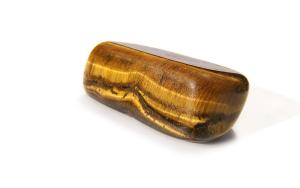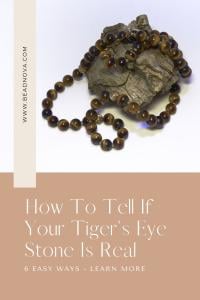Tiger’s eye stones have captivated people for centuries with their stunning beauty and unique properties. However, as demand for these striking stones grows, so does the market for counterfeit versions. In this article, we will explore how to tell if tiger eye stone is real by examining its color, appearance, and chatoyancy, among other factors. By learning the differences between real vs fake tigers eye, you can ensure that you are getting the genuine article and not a mere imitation. So, let’s dive into the world of tiger’s eye and learn how to identify tiger eye with confidence.
Table of Contents
A Comprehensive Guide to Identifying Genuine vs Fake Tiger’s Eye
1. Inspect the Color and Appearance
The first step in determining the authenticity of a tiger’s eye stone is to closely inspect its color and appearance. Genuine tiger’s eye stones typically exhibit a range of rich golden-brown to reddish-brown hues with silky, parallel bands of color. When moved under a light source, these bands create a mesmerizing, shifting pattern known as chatoyancy.
Fake tiger’s eye stones, on the other hand, often lack the depth and richness of color found in real specimens. Counterfeit stones may be painted or dyed to mimic the appearance of a genuine tiger’s eye, but they often fall short of capturing the stone’s characteristic luster and texture. By closely examining the stone’s color and appearance, you can get a better idea of whether it is genuine or counterfeit.
2. Examine the Chatoyancy (Cat’s Eye Effect)

This file is licensed under the Creative Commons Attribution-Share Alike 3.0 Unported
One of the most distinctive features of genuine tiger’s eye stones is their chatoyancy, also known as the cat’s eye effect. This optical phenomenon occurs when light reflects off the parallel fibers within the stone, creating a captivating, shimmering appearance that resembles the eye of a cat. Chatoyancy is a key indicator of a real tiger’s eye stone, and understanding how it differs between genuine and fake stones will help you determine their authenticity.
To observe chatoyancy, hold the tiger’s eye stone under a direct light source and slowly rotate it back and forth. In genuine stones, the cat’s eye effect should be clearly visible, with smooth and consistent bands of light moving across the stone’s surface. The bands should shift gracefully as you change the angle, creating a captivating visual effect.
In contrast, fake tiger’s eye stones may either lack chatoyancy altogether or exhibit an inconsistent, poorly defined effect. Counterfeit stones made from materials like glass or resin may have a superficial resemblance to real tiger’s eye but will not display the same depth and richness of chatoyancy. By examining the stone’s cat’s eye effect, you can further distinguish between real and fake tiger’s eye stones, ensuring you know exactly what you are dealing with.
3. Test the Hardness and Durability
Another important factor in determining the authenticity of a tiger’s eye stone is its hardness and durability. Genuine tiger’s eye is a relatively hard stone, with a Mohs hardness rating of 6.5 to 7. This means that it is resistant to scratches and is less likely to chip or crack compared to fake stones made from softer materials.
To test the hardness of your tiger’s eye stone, you can perform a simple scratch test. Use a steel nail or a sharp, hard object to try and scratch the stone’s surface gently. A real tiger’s eye stone should be resistant to scratches, while fake stones may exhibit marks or damage more easily. Keep in mind that this test can be inconclusive, and it’s essential to consider other factors to accurately determine the stone’s authenticity. Nevertheless, it is a useful tool in understanding how to tell if tiger eye stone is real.
4. Check the Stone’s Temperature
Another useful method in differentiating between real vs fake tigers eye stones is checking the stone’s temperature. Genuine tiger’s eye stones are known for their ability to retain heat, which means that they will feel warmer to the touch than their counterfeit counterparts made from materials like glass or plastic.
To test the stone’s temperature, hold it in your hand for several minutes, allowing it to absorb your body heat. A real tiger’s eye stone should feel warm to the touch, while fake stones may remain cool or quickly lose warmth. This simple test can provide valuable insight into the stone’s authenticity and help you in your quest to how to identify tiger eye.
5. Analyze the Stone’s Weight and Density
Genuine tiger’s eye stones have a specific weight and density that can also help you distinguish them from counterfeit versions. Real tiger’s eye has a density of approximately 2.64 to 2.71 g/cm³, making it moderately heavy for its size. Counterfeit stones made from materials like glass, resin, or plastic may differ significantly in weight and density, often feeling lighter or heavier than genuine specimens.
To analyze the stone’s weight and density, compare it to a known genuine tiger’s eye stone of similar size. If the weight and density feel markedly different, this could be an indication that the stone you’re examining is fake. While this method is not foolproof, it can provide valuable information in combination with the other tests mentioned, allowing you to accurately determine the authenticity of a tiger’s eye stone.
6. Consult an Expert or Seek Professional Testing
While the methods we’ve discussed can provide valuable insights, sometimes it’s best to consult an expert or seek professional testing to definitively determine whether a tiger’s eye stone is genuine. Gemologists and other professionals have the knowledge, experience, and specialized equipment to accurately identify stones and differentiate between real vs fake tigers eye.
One of the tests professionals may perform is Raman spectroscopy, a non-destructive technique that can accurately identify the chemical composition of the stone. By analyzing the results, an expert can confirm whether the stone is a genuine tiger’s eye or a counterfeit. While seeking professional advice may involve additional time and cost, it can provide you with peace of mind and certainty when it comes to determining the authenticity of your stone, making it a worthwhile investment in your quest to how to identify tiger eye.
Conclusion
In this article, we’ve explored six easy ways to help you determine if your tiger’s eye stone is real or fake. By inspecting the color and appearance, examining the chatoyancy, testing the hardness and durability, checking the stone’s temperature, analyzing the weight and density, and consulting an expert or seeking professional testing, you can confidently assess the authenticity of your tiger’s eye stones. Remember that each method may not be conclusive on its own, but when used in combination, they provide a solid foundation for understanding how to tell if tiger eye stone is real.
Armed with this knowledge, you can make informed decisions when purchasing, collecting, or selling tiger’s eye stones, ensuring you’re dealing with genuine specimens and not falling for imitations. By learning how to distinguish between real and fake tiger’s eye stones, you can fully appreciate their unique beauty and significance, and cultivate a collection that you can treasure for years.
More articles about gemstones you like:
The Ultimate Guide To Using Healing Crystal For Beginners
5 Easy Ways on How to Tell if Amethyst is Real or Fake
7 Ways On How to Tell If Your Clear Quartz Is Real or Fake
Blue Tiger’s Eye: Meaning, Healing Properties, Benefits, and Uses
Red Tiger’s Eye: Meaning, Healing Properties, Benefits, and Uses
Tiger’s Eye Healing Properties by 3 Colors That You Should Know
Are Blue and Red Tiger’s Eye Fake Gemstones?





Leave A Comment